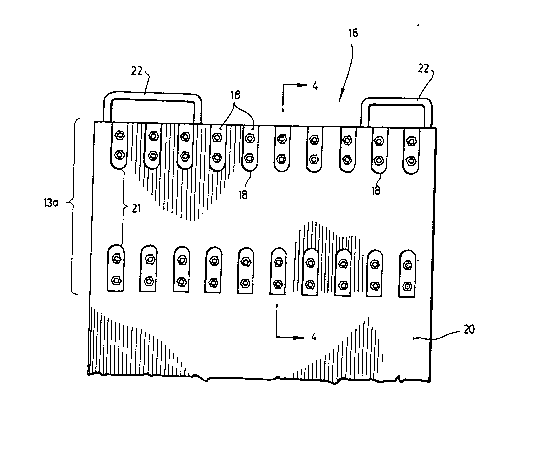Some of the information on this Web page has been provided by external sources. The Government of Canada is not responsible for the accuracy, reliability or currency of the information supplied by external sources. Users wishing to rely upon this information should consult directly with the source of the information. Content provided by external sources is not subject to official languages, privacy and accessibility requirements.
Any discrepancies in the text and image of the Claims and Abstract are due to differing posting times. Text of the Claims and Abstract are posted:
| (12) Patent: | (11) CA 2061864 |
|---|---|
| (54) English Title: | DEVICE FOR MOVING LARGE AND HEAVY LOADS |
| (54) French Title: | DISPOSITIF UTILISE POUR DEPLACER DES CHARGES LOURDES ET DE DIMENSIONS CONSIDERABLES |
| Status: | Expired and beyond the Period of Reversal |
| (51) International Patent Classification (IPC): |
|
|---|---|
| (72) Inventors : |
|
| (73) Owners : |
|
| (71) Applicants : |
|
| (74) Agent: | ROBIC AGENCE PI S.E.C./ROBIC IP AGENCY LP |
| (74) Associate agent: | |
| (45) Issued: | 1996-08-27 |
| (22) Filed Date: | 1992-02-26 |
| (41) Open to Public Inspection: | 1993-08-27 |
| Examination requested: | 1992-02-26 |
| Availability of licence: | Yes |
| Dedicated to the Public: | N/A |
| (25) Language of filing: | English |
| Patent Cooperation Treaty (PCT): | No |
|---|
| (30) Application Priority Data: | None |
|---|
A device for moving large and heavy apparatuses combining
modular rail sections positioned one after the other to form
two parallel rails onto which slides a load-carrying plate
extending transversally between the rails. The upper
surface of the rail section has a central row of upwardly
projecting supporting elements positioned at regular
intervals along its length. The undersurface of the carrying
plate has two opposite edge portions each having two
parallel rows of guiding elements projecting down and
positioned at regular intervals along its length. When the
plate is positioned on top of the rails, the two rows of
guiding elements define a guiding channel which may
releasably engage the central row of supporting elements
projecting up the corresponding rail. The upper layer of
each supporting elements and the bottom layer of each
guiding elements are made of a friction material, either low
friction material to facilitate movement therealong or high
friction material to enhance friction. Also, the central
row of supporting elements of the rails are sized to act as
retaining means for a hydraulic jack to push the carrying
plate.
Note: Claims are shown in the official language in which they were submitted.
Note: Descriptions are shown in the official language in which they were submitted.

2024-08-01:As part of the Next Generation Patents (NGP) transition, the Canadian Patents Database (CPD) now contains a more detailed Event History, which replicates the Event Log of our new back-office solution.
Please note that "Inactive:" events refers to events no longer in use in our new back-office solution.
For a clearer understanding of the status of the application/patent presented on this page, the site Disclaimer , as well as the definitions for Patent , Event History , Maintenance Fee and Payment History should be consulted.
| Description | Date |
|---|---|
| Time Limit for Reversal Expired | 2009-02-26 |
| Letter Sent | 2008-02-26 |
| Inactive: IPC from MCD | 2006-03-11 |
| Inactive: IPC from MCD | 2006-03-11 |
| Letter Sent | 2000-02-03 |
| Letter Sent | 1999-12-23 |
| Grant by Issuance | 1996-08-27 |
| Application Published (Open to Public Inspection) | 1993-08-27 |
| All Requirements for Examination Determined Compliant | 1992-02-26 |
| Request for Examination Requirements Determined Compliant | 1992-02-26 |
There is no abandonment history.
| Fee Type | Anniversary Year | Due Date | Paid Date |
|---|---|---|---|
| MF (patent, 6th anniv.) - small | 1998-02-26 | 1998-02-11 | |
| MF (patent, 7th anniv.) - small | 1999-02-26 | 1999-02-15 | |
| Registration of a document | 1999-08-23 | ||
| MF (patent, 8th anniv.) - small | 2000-02-28 | 2000-02-14 | |
| MF (patent, 9th anniv.) - small | 2001-02-26 | 2001-01-31 | |
| MF (patent, 10th anniv.) - small | 2002-02-26 | 2001-12-07 | |
| MF (patent, 11th anniv.) - small | 2003-02-26 | 2003-01-24 | |
| MF (patent, 12th anniv.) - small | 2004-02-26 | 2004-01-05 | |
| MF (patent, 13th anniv.) - small | 2005-02-28 | 2005-02-08 | |
| MF (patent, 14th anniv.) - small | 2006-02-27 | 2006-01-17 | |
| MF (patent, 15th anniv.) - small | 2007-02-26 | 2007-02-19 |
Note: Records showing the ownership history in alphabetical order.
| Current Owners on Record |
|---|
| 2866-0322 QUEBEC INC. |
| Past Owners on Record |
|---|
| MICHEL LUSSIER |